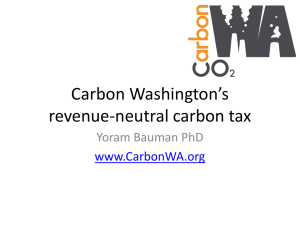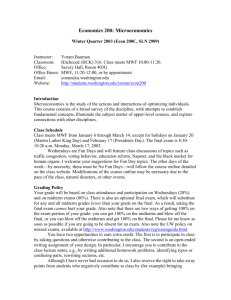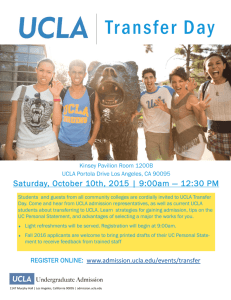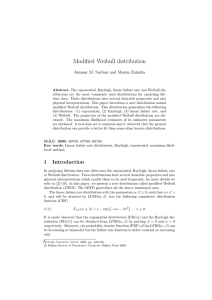WaTeR
advertisement
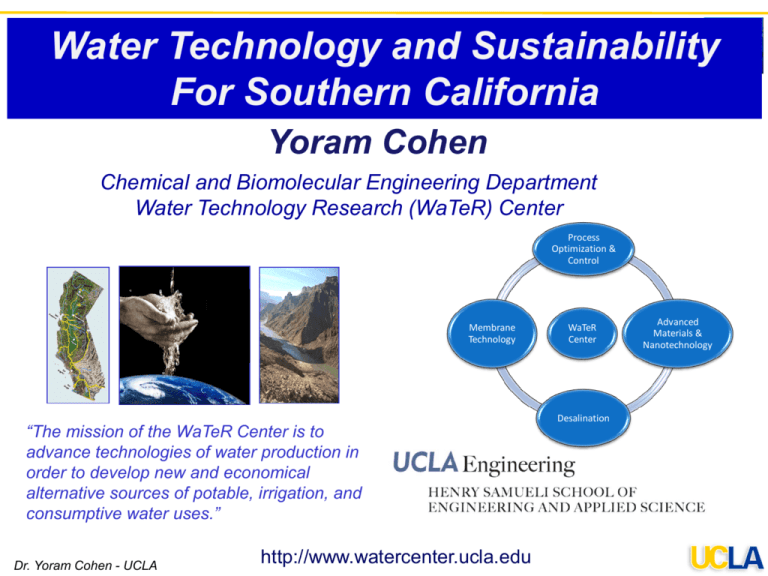
Water Technology Research Center Water Technology and Sustainability For Southern California Yoram Cohen Chemical and Biomolecular Engineering Department Water Technology Research (WaTeR) Center Process Optimization & Control Membrane Technology “The mission of the WaTeR Center is to advance technologies of water production in order to develop new and economical alternative sources of potable, irrigation, and consumptive water uses.” Dr. Yoram Cohen - UCLA http://www.watercenter.ucla.edu WaTeR Center Desalination Advanced Materials & Nanotechnology MWD Water Portfolio Responsibility MWD Water Responsibility • MWD customers demand water for human consumption, sanitation, fire protection, agriculture, landscaping, recreation, and industrial production. • The volume of water needed to provide the needs of MWD customers could vary in the future with new technology, changing lifestyles, and new patterns of urban development. Water Portfolio Imported water Groundwater Water-use efficiency Wastewater Rainwater Seawater MWD/BRC Dr. Yoram Cohen - UCLA Water Technology Research Center California Water Supply Salinity: 3000-30,000 mg/L TDS Southern California’s population is projected to increase by 8 Million by Year 2020 (12 M increase for CA ; 35M 47 M) SACRAMENTO CLIFTON COURT SACRAMENT RIVER O MONO LAKE FOREBAY San Francisco Water Technology Research Center SAN JOAQUIN RIVER DELTAMENDOTA CANAL FRESNO SAN LUIS RESERVOIR LOS ANGELES AQUEDUCTS (2) California Aqueduct KERN RIVER LAKE BUENA VISTA EAST BRANCH WEST BRANCH Colorado River Aqueduct SAN BERNARDINO COLORADO RIVER LOS ANGELES Imported Water SAN DIEGO Dr. Yoram Cohen - UCLA MWD Service Area Groundwater Water Energy Use for Water Production, Treatment & Distribution – The California Example Water conveyance cost Reclaimed water Water Desalination cost ~2.5 kwh/m3 ~1 kwh/m3 ~1–5 kwh/m3 Electricity: 19% of State Use Reduction in water conveyance will reduce energy consumption and the carbon footprint Dr. Yoram Cohen - UCLA Water Technology Research Center Water Use in Southern California: The Case for Municipal and Industrial (M&I) Water Recycling 8000 ~20% of CA total Water Use (MGD) 7000 6000 5000 ~50% 4000 ~18 M people 3000 42% 2000 ~4 M people 1000 8% 0 California M&I South Coast HR M&I – municipal and industrial; HR – hydrologic region LADWP MWD Dr. Yoram Cohen - UCLA Water Technology Research Center We are Surrounded by Saline Water Agricultural Drainage Water (ADW) Salinity: 5,000 30,000 mg/L TDS Brackish Ground Water (BGW) Salinity: 2,000 - 15,000 mg/L TDS Colorado River Water (CRW) Seawater Salinity: ~35,000-38,000 mg/L TDS Salinity: 700-1000 mg/L TDS • Drought conditions and increasing population necessitate smarter water production and reclamation • Opportunity to produce/reclaim water from several sources – Agricultural drainage water – Brackish groundwater – Seawater – Wastewater • CA is a net salt importer Secondary/Tertiary treated municipal wastewater effluent: 500-1500 mg/L TDS McCool et al., Desalination, 261 (2010) 240-250 Water Technology Research Center Dr. Yoram Cohen - UCLA Metropolitan’s 2011 Business Model Incentives for advanced technology use/development Develop new imported supplies to meet growing demand Water Technology Research Center Major Challenges Local supply development Improved regional storage Delta restoration and conveyance Climate change Natural disaster and terrorism Rising energy costs Moderate demand through conservation programs and subsidies to members Enable members to take actions they could not take individually Subsidize local supply projects Lead regional integrated resource planning process Subsidize conservation and some local production MWD/BRC Dr. Yoram Cohen - UCLA fostering a water service and technology innovative region MWD and Water Technology • Host prototype technology demonstration efforts. • Partner with member agencies in their technology-adoption and demonstration efforts. • Work with national trade associations to set – Performance standards to guide the water technology industry. – Standards and steps necessary for technology deployment & acceptability. • Serve as a conveyer of, and venue for, meetings among entrepreneurs, innovators, researchers, investors, and water policy officials in the public, private, and academic communities. • Participate in state-level and regional efforts aimed at developing regional technology clusters. In acting as an active sponsor, convener, conduit for information, and possibly even technology vendor, MWD could affect not only its capacity to perform its own missions but also the very nature of the region it serves. MWD/BRC Dr. Yoram Cohen - UCLA Water Technology Research Center Water Conservation and New Water Sources Water Technology Research Center Public perception may be limiting the adoption of efficient conservation technologies For many water costs are a small fraction of living costs Cost-effectiveness of urban conservation methods often do not consider the “human factor” Water use efficiency and energy are linked but the detailed impact of specific water conservation approaches needs to be quantified Capital investment return on investment Institutional constraints Cost of new water sources relative to the cost investment in water conservation and use efficiency Future projections should consider an future technological advances incentive for technological advances MWD/BRC Dr. Yoram Cohen - UCLA MWD and Future Technologies Advances in technology are highly likely to reduce the costs of desalination, recycling, groundwater storage, and other options. Smart meters Water Technology Research Center Water quality monitoring Water use efficiency • Smart irrigation • Efficient water use in appliances • Efficient indoor water use Greywater reclamation/recycling/reuse Wastewater reuse Leak detection in water delivery systems Major question: How quickly will technological advances occur and be commercialized, and at what cost will those options become more attractive relative to the purchase of imports? MWD/BRC Dr. Yoram Cohen - UCLA Reduction of water evaporation in conveyance systems Seawater desalination Water supply storage & forecasting Renewable energy sources for water conveyance and treatment Technological Achievements and Opportunities Waste water can be treated to level of drinking water standard Brackish water desalination can be achieved up to 95% recovery in some cases Seawater can be desalted at reasonable cost (as low as ~$0.50-0.55 /m3) Biological treatment can be carried out in small packed plants owing to developments in membrane bioreactors New generation of membranes enable significant reduction in the size of water treatment/ production plants The technology for compact distributed water treatment/reclamation and reuse is at our doorstep High Recovery Desalting (RO integrated with chemical demineralization Dr. Yoram Cohen - UCLA Water Technology Research Center Water Technology Research Center QUESTIONS?

